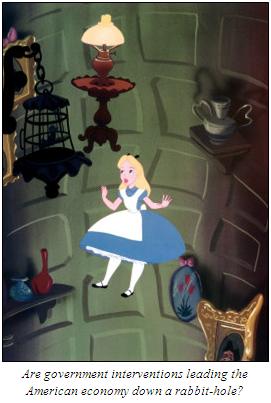“Down, down, down. Would the fall never come to an end!”—Alice’s Adventures in Wonderland, “Down the Rabbit-Hole,” by Lewis Carroll.

It is expected that Mr. Geithner will be unveiling the next installment of the so-called Troubled Asset Relief Program, into which the Congress has already misinvested a staggering $700 billion. It’s a program that, ironically, was not used to purchase so-called troubled assets at all—the “toxic” mortgage-backed securities.
Instead, banks were recapitalized, automakers given loans, and insurance companies rescued from suffering their own self-ordained fate. Banks like Bank of America, which according to OpenSecrets.org, received some $45 billion in TARP funds for recapitalization; Citigroup, which received $50 billion; AIG, which received $40 billion; and on down the line—all were put on the taxpayer dole. Interestingly enough—and not so coincidentally—just these three entities alone spent a combined $26.14 million in lobbying efforts and $11.48 in political contributions in 2008.
Overall, OpenSecrets.org calculates that TARP recipients received a whopping 267,208 percent return on their investment in politicians and the electoral system. And the same politicians who received the largesse continue to assure the American people that they will actually make money on this ill-conceived “investment”—since the taxpayers now technically own devalued shares in these troubled banks.
All of which may make sense—in Wonderland. The American taxpayer—already fleeced by the IRS and virtually bankrupted by profligate government spending—has now been forced to invest much-needed funds into insolvent banks. Why, that’s a lot like investing tax dollars in otherwise defunct car companies, or broke state governments, or… well, you get the idea.
Included in the next installment of TARP, according to the New York Times’ David Sanger, are “billions of dollars more to prevent home foreclosures, for fear that displacement and anger created by throwing people out of their homes, and putting more properties onto a glutted market, will create a psychological and financial death spiral.”
So, as a final insult—and in the final payoff—these houses are simply going to be handed over to the delinquent borrowers. They’ll have their principals reduced, their rates cut, and the terms extended. All at taxpayer expense as Congress steals from the people who do pay their bills to give to those who should have never been given the now “troubled” loans in the first place.
In a way, it is fitting that the flim-flam artist touting the next great bailout—which will cost hundreds of billions of dollars—is Mr. Geithner. As noted by Bob Novak last March in his piece, “Fed on a Limb,” it was Mr. Geithner as then-head of the New York Fed who orchestrated the opening of the Fed’s discount window to investment banks that resulted in JP Morgan being loaned $29 billion in taxpayer funds to purchase Bear Stearns. The taxpayers, by the way, did not receive one share of Bear Stearns stock in return. Nor a please or thank you, for that matter.
Ever since then, the nation has fallen ever further down the rabbit-hole of bailouts. As summarized succinctly by ALG Chairman Howie Rich: “$2 trillion in FDIC assurances, $1.75 trillion in Federal Reserve commercial paper purchases, $900 billion in term auction facility lending, $600 billion to insure money market funds, $600 billion to cover Fannie and Freddie’s worthless mortgage-backed securities, $550 billion for discount Federal Reserve loans, $500 billion to insure FDIC deposits, $300 billion for FHA mortgage relief, $250 billion for Citigroup debt, $225 billion for securities loan facility lending, $200 billion for Fannie and Freddie’s debt, $112 billion for A.I.G., and on down the line.” All, of course, on the taxpayer’s tab.
In the process, the economy has tanked along with revenues to state and federal governments. As a result, the federal deficit is projected to be anywhere from $1.2 trillion to $2 trillion for 2009. And the national debt grows exponentially, currently standing at $10.7 trillion. More than one economist has noted that government interventions to date have actually worsened the impact of the financial miasma.
The real trouble with the “clogged” credit markets has been—and still is—the pricing of the mortgage-backed securities. The fact is, if securities purchased come to include a plethora of foreclosed properties, they are naturally worth less than they were bought for. Like most investments that decrease in value, the holders of those investments tend to lose money. And these holders should emphatically not be the taxpayers.
The only legitimate—and in the long run, effective—solution is for those who made poor investments to lose their money. Let the foreclosures happen. Let the loans go into default. Let the holders of the securities pay the price for their own bad investments. That certain favored financial institutions would most certainly fall as a result should not spook lawmakers who are being asked now to just keep handing blank checks over to the Treasury.
Congress should let failed institutions finally fail, and the net benefit will be that poor decision-makers are rooted out of the marketplace. And then, at the end of the day, the financial firms and banks still standing will buy everything up at a big discount—instead of the government at inflated values with the design to cultivate political constituencies.
Property values would fall, yes, but the market would finally hit its bottom, a necessary step that has been forestalled for almost a year now by over-interventionism, central-planning, and a bumbling bureaucracy.
And instead of continuing to fall “down, down, down” the great big rabbit-hole, the American economy can return to the path of fiscal sanity, individual responsibility, and eventually, national prosperity. The alternative is yet another jaunt with the Treasury Secretary as he once again morphs into the late White Rabbit and dashes madly through Alice’s Wonderland—all at taxpayer expense.
Robert Romano is the Editor of ALG News Bureau.

